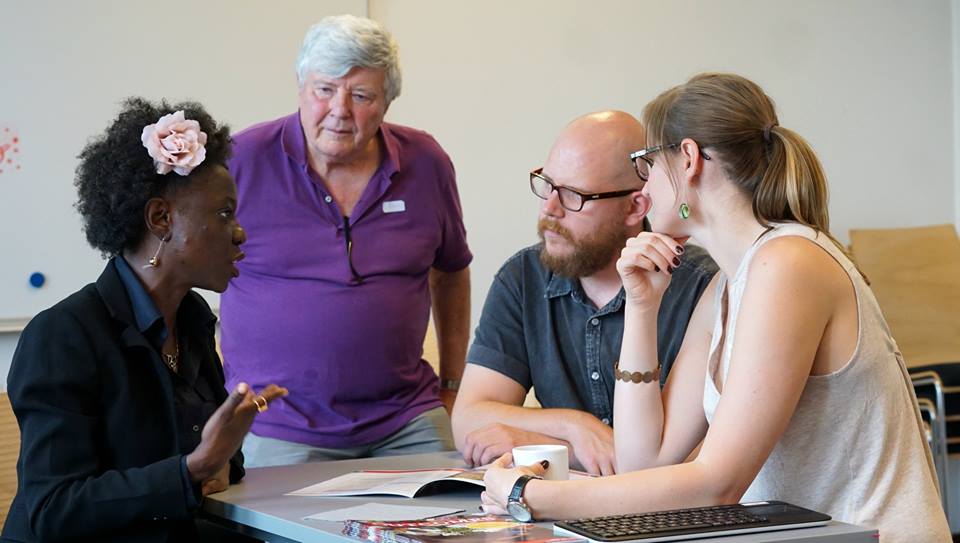English for EduCharity: Giving Teacher Training in the Philippines
When Richard took a shot at teaching English 10 years back, little did he know where it would lead him one day. Here, he relates his summer experience of delivering a teacher training course for charity in the Philippines.
Adventure calling
It started with a phone call on my university graduation day in July 2015. A small team of teacher trainers were due to fly out to Manila the following month to deliver a two-week training course, but one of the trainers had to drop out because of passport issues.
The project was a collaboration between two Rotary clubs in the UK and the Philippines. Its objective was to improve the teaching quality of a school in Manila, which had been built from upcycled shipping containers in a previous project.
On the phone, I was asked whether I could fill in for the missing trainer and co-deliver the course (which had still yet to be written). I said I’d need a few days to think about it, as I would need to organise some things. Besides, I was concentrating on having a great day with my family following completing university.
Despite this, there was only one answer in my mind and I called the person back 20 minutes later saying to count me in.
Pulling together to make things work
Due to a breakdown in communication between us and the school, we had to work with very little information about where we were going, the teachers we’d be teaching, the types of courses they taught and what they were expecting from us.
Notwithstanding, we pooled our combined knowledge and experience together. Working as a team, we designed a training course that we thought made sense and was beneficial to the teachers in Manila.
The place of action
The school is situated in the district of Tondo and sits right on the foot of ‘Smokey Mountain’, a truly enormous landfill site. Its name comes from the noxious gas clouds that the waste creates and the size of the site.
The school Life in the slums
This is home to around 25,000 people and is one of the most impoverished places in the world. The people there live in slums, and the family members, including the children (regardless of how young they are) pick through the landfill finding things to sell.
Some of the children that go to the school often fall asleep in class because they are so tired from foraging until the early hours of the morning. Attendance can vary from child to child due to family problems, including severe illness of a family member, domestic violence and sexual assault.
A challenging arrival
We arrived in Manila, jet-lagged and tired, but excited to meet the 28 teachers and the school staff members. There is no public transport infrastructure in Manila, so everyone travels by car. We got picked up by the school’s minibus driver and made our way from central Manila to Tondo.
This journey of only a few kilometres ranges from twenty minutes to three hours, depending on the traffic. The gradient of scenery also changes along the road – starting with the downtown buildings to shacks made from corrugated iron and wooden pallets.
Happyland Smelly neighbour: the local sewage plant
When we arrived at the school, the most noticeable thing was the smell. Due to the location of the school next to a giant bin and the very warm and humid climate, the initial smell was almost too much to bear. Try sticking your head in the communal bins on a hot day, for eight hours.
Making necessary readjustments
We observed most of the 28 teachers over the next two days and got together to discuss the results. We came to the conclusion that most of the sessions we had thought would be relevant to the teachers were actually irrelevant. Also, we all saw where the teachers had gaps in their knowledge and technique, and where we could give more useful sessions in replacement for the ones that we took away.
This did mean though that we were now writing sessions in our accommodation’s lobby after arriving back from the school in preparation for the next day. Even more of a challenge when hot, tired, and still jet-lagged!
Once we had cracked that nut, it was relatively plain sailing from there. The training sessions were well-received by the teachers, and we felt like we were giving a lot more beneficial training – and ultimately having a lot more fun and rewarding experience.

Teacher problems: traditional roles
One observation, and one of our biggest challenges, was to break the teachers out of the classical teacher role: the teacher stands at the front of the class and tells the students the information. The teacher also writes on the blackboard and dictates which student should speak and when they should stop.
The more you’re doing as a teacher in the classroom, the less your students are doing.
This role, we strongly assumed, came from the teacher’s preconceived notions of what a teacher ‘should’ be like. It was most likely due to their past learning experiences, and/or having learned this during their teacher qualifications.
In subjects such as English and the subjects taught through the medium of English (see Content and Language Integrated Learning ‘CLIL’) a seemingly one-to-one information exchange from teacher to learner is not sufficient enough for language acquisition.
Facilitating rather than teaching
This is where a teacher could design a lesson in order for him/her to ‘take a back seat’ in the class and let the students take the reins in order to have as much (meaningful) practice of the language as they can.
You earn your pay check in the effective planning of the lesson and the progress of the students.
Initially, the teachers may feel that they are not in control, or are not doing enough in order to feel like they are earning their salary; but in fact, you earn your pay check in the effective planning of the lesson and the progress of the students.
In this more up-to-date model, the teacher can act as a facilitator rather than a teacher: helping students discover the language by creating situations and activities for meaningful practice and provide input when necessary, rather than ‘teaching’ the students contrived language.
[…] facilitate learning by giving more autonomy and responsibility to [the students] but being there when they make mistakes or have a question or get a little lost.
A little off topic, but I’d also like to take the opportunity here to say that, despite having almost nothing, living in the conditions described above, and what these people must have to go through on a daily basis, you couldn’t meet a happier bunch. They were so kind, so polite and helpful, and really couldn’t do enough for you.
They all had grins from ear to ear and lived life appreciating and celebrating what they do have, and not focussing on what they don’t have. Walking through the slums and working in this area was a little daunting for me at first. However, the people there made us all feel welcome.
Visiting again a year later
The teacher training team returned back a year later to run an evaluation on the teaching of the school. We saw a lot of familiar, friendly faces, and also some new ones.
It was great to see that the teachers had taken some of the training on board and have implemented a number of the ideas in their classes. A few teacher-led classes still remained of course, and a few old habits. But on the whole, the students seemed to be more involved in the process – and that for me was mission complete.
All in all, I am very thankful to be able to have had that experience in such a place. I will take the memories and the things that I learned with me for a long time.



















